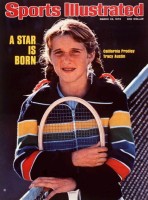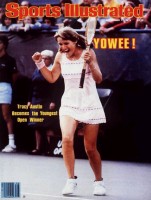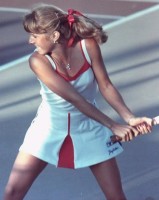|
Excerpts from Beyond Center Court: My Story by Tracy Austin with Christine Brennan, 1992, Wm Morrow & Co, NY Out of print, obtainable used from Amazon.com via the link above. Beyond Center Court appears to have been edited together from taped interviews, and the job was well done. Tracy Austin's storytelling narrative is clear, and the book is full of interesting anecdotes and evaluations of other tennis players--not only pros, but also celebrities (Sean Connery gets a "B-minus", while Peter Jennings gets an "A"). The only confusion comes from a tendency toward chronological meandering--getting ahead of the story, then backtracking--which is common in taped interviews, and not at all fatal in this case. The book also is indexed, which makes it far more useful for historical research and reference. Photo: Tracy with a Porsche she won at the tourney in Stuttgart (now held in Filderstadt), where she was champ in '78, '79, '80, & '81 |
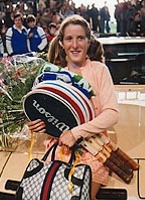 |
Lansdorp was a reserve on Holland's 1959 Davis Cup team who emigrated to the US when he found that American colleges gave scholarships to tennis players (he attended Pepperdine U.). He later coached Lindsay Davenport from age 9 to about 14, and also worked with Pete Sampras. As of 2004, he is one of the primary coaches of 17-year-old Russian Maria Sharapova--although he doesn't often travel on the WTA Tour with her.
|
Robert, a huge Dutchman with long, floppy hair in the style of the day, was a tough guy whom I knew loved me underneath... I wanted to kill him every day at practice--and that was exactly how he wanted me to feel... I still had a two-handed forehand. When he saw me, he said, "Its time to change." So I switched. I found out later that Robert didn't exactly think "U.S. Open champion" when he first laid eyes on me. He told the Los Angeles Times in 1976: When I first saw Tracy, I wasn't that gung ho. She was so little. I could see potential, but I wouldn't have said, "Oh, Mrs. Austin, she is going to be the greatest. It is a long process to become a champion, but gradually I saw her greatness. She learned quickly and accepted criticism. She can tell you what she did wrong without asking. I work her very hard, sometimes to the point where she wonders why. But the day after a hard session she comes back and works even harder and will be disappointed if I don't push her even harder. I'm not sure whether it is because she wants to be the best or wants to please me." ...Robert became, arguably, the most important force in my life for my young tennis career. He was part father, part brother, part tyrant. The perfect coach. He worked us hard, but we also had fun... ...By the time I was nine, I was frequently asked to play exhibitions at grand openings, fund-raisers for charities, and other special events... |
When Tracy was 10, she played Roy Emerson in an exhibition in which he let her win, and Bobby Riggs in an exhibition which she lost-- she would defeat Riggs in an exhibition when she was 13.
|
...when I was eleven, I won my first nationals at Savannah, defeating Kelly Henry in the finals. ...in January, 1977... my mother suggested I go with my brother Jeff to Portland, Oregon, where he had a men's professional tournament. She thought it would be good for me to play some matches in the women's tournament that was going on at the same time... Over the holidays, I had won an important tournament, the Fiesta Bowl girls-eighteen-and-under championship in Tempe, Arizona [Tracy had just turned 14]... ...I went up to Portland with Jeff... and began playing in the Pacific Coast Indoor Tennis Championships... [Tracy won both her qualifying round matches to get into the main draw...] At that time, I realized that this was more than a local event-- this was a professional tour stop... The event was called the Avon Futures, a satellite tour of the Virginia Slims... ...From one match to the next, I kept on winning... I moved to the quarterfinals and defeated nineteen-year-old future TV commentator Mary Carillo 6-2, 6-3... |
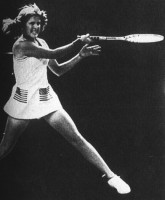 Tracy in Wightman Cup play photo from the book |
|
...The four semifinalists qualified to play in the Virginia Slims tournaments the next two weeks. So I was going to Houston and Minneapolis--if my parents and teachers said OK. ...In the finals, I played Stacy Margolin of Beverly Hills, who was John McEnroe's girlfriend, and won when she retired from the match with blisters on her feet in the third set, 6-7, 6-4, 4-1... The prize money for first place was twenty-eight hundred dollars, but I didn't take it because I was still an amateur, and was planning to remain one for a while. | |
The prize money for winning the 1979 US Open was $39,000. In 2003 the US Open the prize money won by the US Open champion-- Justine Henin-Hardenne-- was $1 million dollars.
|
Tracy on other WTA players: (pages 198-203) [Steffi Graf] ...She has more athletic talent than the others. Her quickness is the key. She doesn't hit her backhand as well as her forehand, but an opponent can't pick on it because she's able to run around it and hit so many winners. Steffi relies on her serve, her forehand, and her quickness... [Mary Joe Fernandez] ...Mary Joe doesn't have one huge forte--not her serve, her forehand, her backhand, her volley--but she's so consistent and mentally tough on key points that she wins. She's just kind of there, but she doesn't miss, she doesn't give away free points, and rarely has a bad loss. She never tries for stupid shots... [Monica Seles] ...she is lethal. Every single point, she is moving her opponent so deep and hitting so hard... Mentally, she must be the strongest player out there right now... [Gabriela Sabatini] ...She has improved a lot. She used to have rather loopy strokes and used to hit the ball off her back foot, falling away from the ball, which is not technically correct. She used up a lot of extra energy, became tired, and had trouble in the third set. Now, however, she is fresher and coming to the net more, hitting flat strokes with a more compact swing and stepping into the ball much better. That improvement and her new-found aggressiveness are what allowed her to win the 1990 U.S. Open. [Jennifer Capriati] Jennifer is terrific... Her serve--the actual service motion--is great. Her strokes are very sound technically... She has the mind to play this game and she's got much better strokes than Steffi or Monica. She is much more technically sound and she's fast... [Hana Mandlikova] ...Of all the players I competed against, Hana Mandlikova had the most talent. When she got up to an easy forehand, she could do twenty things with it. I had three choices, so it wasn't as difficult. I just hit the ball and won the point. Hana, however, might have hit an underspin drop shot angle--a very low percentage shot. All the options get confusing. Hana hits a lot of risky shots that make her fun to watch, though. [Martina Navratilova] ...When I first came on the circuit, her backhand was a glaring weakness. She could only slice it without generating much power. But she worked hard on it and now has a topspin backhand that is much more of a weapon. [Chris Evert] ...Chris Evert never, ever, gave you anything. Her shot selection was very basic--either to hit it crosscourt or down the line, deep or with sharp angles. High-percentage, well-thought-out shots. I obviously was the same as Chris, having fewer choices... |
Tracy Austin page at the International Tennis Hall of Fame
Tracy Austin profile at WTATour.com
Tracy Austin page from the ITF Database: 336 wins, 82 losses
(may not include all tourneys)
Find more books by or about Tracy Austin at Amazon.com
Find tennis shoes made by: adidas -- Nike -- Fila -- Reebok
Find tennis racquets made by: Yonex -- Wilson -- Head -- Prince -- Babolat
Find tennis balls made by: Wilson -- Dunlop -- Penn -- Tretorn -- Slazenger
Tennis pages at quickfound.net:
- Tennis History Book Excerpts:
Beyond Center Court: My Story by Tracy Austin with Christine Brennan
Tennis Styles and Stylists by Paul Metzler
Chrissie: My Own Story by Chris Evert with Neil Amdur
Courting Triumph by Virginia Wade with Mary Lou Mellace
The Game by Jack Kramer about Pauline Betz & Gussy Moran & more
Courting Danger by Alice Marble with Dale Leatherman
Evonne!: On the Move by Evonne Goolagong with Bud Collins
Court On Court: A Life in Tennis by Margaret Smith Court
Goddess & the American Girl: Suzanne Lenglen & Helen Wills by Larry Englemann
Hard Courts by John Feinstein about Mary Carillo & John McEnroe & more
Ladies of the Court by Michael Mewshaw about Mary Joe Fernandez & more
A Long Way, Baby by Grace Lichtenstein about Rosie Casals
Monica by Monica Seles & My Aces, My Faults by Nick Bollettieri Seles at Bradenton
Tough Draw by Eliot Berry about Nick Bollettieri
The Courts of Babylon by Peter Bodo: Tournament Draws
The Courts of Babylon by Peter Bodo: Dawn of the Pro Tours
- Tennis Articles
1946 TIME: Pauline Betz, Doris Hart, Beverly Baker, Gussie Moran
plus current tennis article feed
1951 & 1952 TIME: Maureen Connolly - Tennis News and Links
- WTA 2004 Desktop Wallpaper
- Justine Henin-Hardenne Desktop Wallpaper
- Maria Sharapova Desktop Wallpaper
- Anastasia Myskina Desktop Wallpaper
- Anna Kournikova News and Links
- Anna Kournikova Desktop Wallpaper
- Martina Hingis News and Links
- 2004 WTA Player Interview Videos
This page's URL is: //tennis.quickfound.net/history/tracy_austin.html
